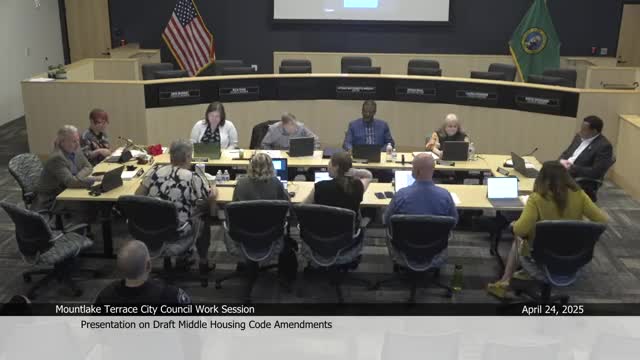Mountlake Terrace presents draft middle-housing code to comply with state mandates; council presses on feasibility and lot coverage
April 26, 2025 | Mountlake Terrace, Snohomish County, Washington
This article was created by AI summarizing key points discussed. AI makes mistakes, so for full details and context, please refer to the video of the full meeting. Please report any errors so we can fix them. Report an error »

City planning staff and outside consultants presented a draft of Mountlake Terrace’s middle-housing code amendments and an associated housing action plan on April 24, describing how the draft responds to state housing laws and the city’s 2024 comprehensive plan.
Christy Osborne, community and economic development staff, introduced the project and said the update implements state requirements including provisions of House Bill 1110 and House Bill 1337. Consultants from Echo Northwest and Methuen presented feasibility analysis, test-fit modeling and draft code language covering allowed housing types, scale controls, bonuses and design standards.
Key features in the draft code: higher allowable densities from R1 to R4 zones tied to smaller setbacks and modest height increases; a separate design chapter regulating building orientation, facade modulation, ground-floor habitable space and unit transparency; an affordability density bonus allowing more units and reduced setbacks for sites that provide income-restricted units; incentives for tree retention (proposed benefit for preserving 25% of significant trees); mid-block connectivity bonuses; and cottage-housing rules (minimum six units to form a cottage court, with carriage houses allowed at a set ratio). The consultants also proposed parking reductions to one stall per unit in R1–R3 and 0.75 stalls per unit in R4, with lower ratios offered as bonuses for affordable housing or tree retention. ADU rules were drafted to comply with HB 1337 (allowing up to two ADUs per lot and up to 1,000 square feet).
The team presented market analysis findings: detached homes and townhomes were generally the most feasible product types under existing market and construction-cost conditions, while four- and sixplexes and small stacked rentals were less feasible without further incentives; increasing unit counts per lot improved development feasibility in test-fit scenarios. Staff said the pro-forma results informed the kinds of density and bonus options embedded in the draft code.
Council questions focused on feasibility versus design controls. Councilmembers asked how proposed lot-coverage limits would interact with recent developments and with detached ADUs, whether lower lot-coverage limits could unintentionally block ADU construction or remodeling, and how the city will reconcile community preferences for tree retention and walkability with the need to make some development types financially viable. Staff said they plan to build an asset/dataset baseline into new asset-management or permitting software and to return with refined performance and mapping data. Planning commission input will continue through a May hearing and additional council work sessions in June before adoption hearings later in the month.
Ending: Councilmembers asked staff and the consultants to return with additional modeling, mapping that shows where R1–R4 will apply, and clearer explanations of how lot-coverage, setback and parking changes affect common project types, and to continue developer interviews and public engagement ahead of formal adoption.
Christy Osborne, community and economic development staff, introduced the project and said the update implements state requirements including provisions of House Bill 1110 and House Bill 1337. Consultants from Echo Northwest and Methuen presented feasibility analysis, test-fit modeling and draft code language covering allowed housing types, scale controls, bonuses and design standards.
Key features in the draft code: higher allowable densities from R1 to R4 zones tied to smaller setbacks and modest height increases; a separate design chapter regulating building orientation, facade modulation, ground-floor habitable space and unit transparency; an affordability density bonus allowing more units and reduced setbacks for sites that provide income-restricted units; incentives for tree retention (proposed benefit for preserving 25% of significant trees); mid-block connectivity bonuses; and cottage-housing rules (minimum six units to form a cottage court, with carriage houses allowed at a set ratio). The consultants also proposed parking reductions to one stall per unit in R1–R3 and 0.75 stalls per unit in R4, with lower ratios offered as bonuses for affordable housing or tree retention. ADU rules were drafted to comply with HB 1337 (allowing up to two ADUs per lot and up to 1,000 square feet).
The team presented market analysis findings: detached homes and townhomes were generally the most feasible product types under existing market and construction-cost conditions, while four- and sixplexes and small stacked rentals were less feasible without further incentives; increasing unit counts per lot improved development feasibility in test-fit scenarios. Staff said the pro-forma results informed the kinds of density and bonus options embedded in the draft code.
Council questions focused on feasibility versus design controls. Councilmembers asked how proposed lot-coverage limits would interact with recent developments and with detached ADUs, whether lower lot-coverage limits could unintentionally block ADU construction or remodeling, and how the city will reconcile community preferences for tree retention and walkability with the need to make some development types financially viable. Staff said they plan to build an asset/dataset baseline into new asset-management or permitting software and to return with refined performance and mapping data. Planning commission input will continue through a May hearing and additional council work sessions in June before adoption hearings later in the month.
Ending: Councilmembers asked staff and the consultants to return with additional modeling, mapping that shows where R1–R4 will apply, and clearer explanations of how lot-coverage, setback and parking changes affect common project types, and to continue developer interviews and public engagement ahead of formal adoption.
View full meeting
This article is based on a recent meeting—watch the full video and explore the complete transcript for deeper insights into the discussion.
View full meeting
